Raynauds Disease

Raynaud’s disease or Raynaud’s syndrome
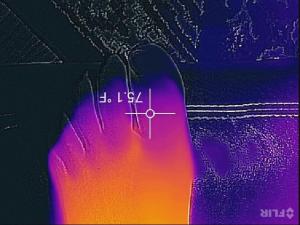 Is a relatively uncommon disorder of the blood vessels. While it’s typically seen in the fingers it can occur in the toes as well. Symptoms include an increased sensitivity to cold and the blanching (whitening) of the affected digits. They may also take on a bluish color. In nearly all cases symptoms appear when the skin is exposed to cold temperatures or the patient becomes stressed.
Is a relatively uncommon disorder of the blood vessels. While it’s typically seen in the fingers it can occur in the toes as well. Symptoms include an increased sensitivity to cold and the blanching (whitening) of the affected digits. They may also take on a bluish color. In nearly all cases symptoms appear when the skin is exposed to cold temperatures or the patient becomes stressed.
These physical symptoms are caused by the action of the many tiny vessels which feed the fingers and toes. When triggered, these vessels start begin to contract and become more narrow. This is known as vasoconstriction, and greatly reduces the total circulation these digits receive. When taken as a whole this sequence of events is known as Raynaud’s phenomenon.
There is no single cause of Raynaud’s disease. It is, however, often seen in patients with autoimmune disorders such as lupus (systemic lupus erythematous) and scleroderma. The condition can also occur alongside several connective tissue disorders.
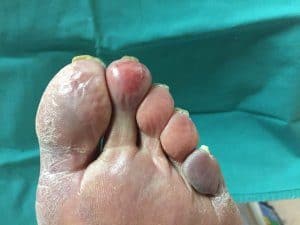 Raynaud’s can’t be cured yet it’s symptoms can be managed successfully. Treatments can be broken down into oral medications, chemical injections, and various lifestyle changes. For many patients a combination of treatments provides the most relief. Also note that Raynaud’s syndrome is almost never dangerous. This leads some patients to choose no treatment at all.
Raynaud’s can’t be cured yet it’s symptoms can be managed successfully. Treatments can be broken down into oral medications, chemical injections, and various lifestyle changes. For many patients a combination of treatments provides the most relief. Also note that Raynaud’s syndrome is almost never dangerous. This leads some patients to choose no treatment at all.
The most popular medication prescribed “off label” to treat Raynaud’s syndrome is the calcium channel blocker Procardia (nifedipine). When used as a compounded cream formulation and applied topically when needed, this drug causes blood vessels in the toes to relax and dilate or widen.
The most popular oral medications used to treat Raynaud’s syndrome are known as calcium channel blockers. This makes sense, since these drugs cause blood vessels throughout the body to relax and dilate or widen. This is known as vasodilation. A good example is Procardia (nifedipine). This drug is normally prescribed to treat the chest pains associated with coronary artery disease.
Drugs in the prostaglandin class have proven themselves effective as well. These drugs are used to treat a variety of conditions ranging from glaucoma to stomach ulcers. As with calcium channel blockers, prostaglandins are sometimes prescribed “off label” to treat Raynaud’s.
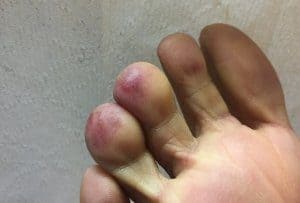
Botox injections smooth out facial wrinkle by temporarily paralyzing the facial muscles which cause them. These are usually the “frowning” muscles of the forehead and between the eyes. In the case of Raynaud’s, Botox blocks the nerves which cause the small vessels of the toes to spasm. Other off-label uses for Botox include relieving tension headaches and preventing excessive foot sweating. When used correctly, botulinum A injections provide up to 5 symptom-free months.
Several simple lifestyle changes can also greatly improve the symptoms of Raynaud’s disease. These do-it-yourself approaches can also improve a person’s overall health and include:
- Quitting smoking. Nicotine is a potent vasoconstrictor. Since vasoconstriction is the direct cause of Raynaud’s syndrome so it’s no surprise that smoking can make symptoms worse. Note that exposure to secondhand smoke can trigger this effect as well.
- Exercise. A sensible exercise program can greatly improve an individual’s circulation. While there’s no cure for Raynaud’s, exercise can reduce a patient’s symptoms to the point that they’re barely noticeable.
- Stress reduction. It’s no secret that stress has the potential to make almost any medical condition worse. Raynaud’s disease is no exception. Diverse methods of controlling stress include yoga, meditation, Tai-Chi, and many others. Simple activities such as talking to a friend or walking a dog can also help. It’s simply a matter of finding what works for you.
- Temperature control. Dress for the weather and avoid sudden changes in temperature. A good example is avoiding the frozen-food section at the grocery store.

- Move your fingers and toes to stimulate circulation.
- If you’re outside get indoors as soon as possible.
- Warm your hands by placing them against your torso or under your armpits.
- Run warm water over the affected fingers or toes. This water should be warm, not hot.
- Move the arms in wide circles in a “windmill” motion.
- Massage the affected fingers or toes.
- Remember to breathe. If stress precipitated the attack this simple advice can make all the difference. Alternately, simply remove yourself from the stressful situation if possible.
Only a trained podiatrist or similar specialist can accurately diagnose Raynaud’s disease. At the Beaver Valley Foot Clinic our podiatrist treats patients with Raynaud’s on a daily basis and knows what works. We offer all of the above treatments—and several others—and have helped thousands of patients find relief. Raynaud’s is treatable, so there’s no reason to keep suffering. Call us today at 878-313-FEET (3338) to book an appointment.
Can Raynaud’s Disease cause complications?
Yes, Raynaud’s Disease can lead to various complications, although they are generally rare. Prolonged and severe episodes of restricted blood flow to the fingers and toes can result in tissue damage, leading to ulcers or, in extreme cases, gangrene. Recurrent episodes of Raynaud’s may also cause thickening and scarring of the blood vessel walls, known as vasculopathy. Furthermore, Raynaud’s Disease can be associated with other underlying conditions, such as connective tissue diseases like systemic sclerosis, which can have their own set of complications. It’s crucial for individuals with Raynaud’s to manage their condition and seek medical guidance to prevent or address these potential complications.
What is the difference between Raynaud’s Disease and Raynaud’s Phenomenon?
Raynaud’s Disease and Raynaud’s Phenomenon, also called Raynaud’s Syndrome, share similar symptoms but differ in their underlying causes. Raynaud’s Disease is a primary condition with no identifiable underlying cause. It typically manifests as recurrent, episodic attacks of fingers and toes turning white, blue, or purple in response to cold or stress. Raynaud’s Phenomenon, on the other hand, is secondary and occurs as a result of an underlying medical condition, often an autoimmune or connective tissue disorder like lupus or scleroderma. It tends to be more severe and may involve additional symptoms. Distinguishing between the two is crucial for appropriate diagnosis and management.
Is Raynaud’s Disease hereditary?
Raynaud’s Disease can have a hereditary component, but it’s not solely determined by genetics. While there is evidence that a family history of Raynaud’s may increase the risk of developing the condition, it’s also influenced by environmental factors and other variables. The exact genetic factors contributing to Raynaud’s susceptibility are complex and not fully understood. Some genetic variations related to blood vessel regulation may play a role. Nonetheless, not everyone with a family history of Raynaud’s will develop the condition, and conversely, individuals without a family history can still develop it.
Raynaud’s Syndrome
and Chilblains, also know as Red, White, and Blue Toe Syndrome, is a condition that causes a person’s toes and fingers (and in some cases the nose and ears) to feel cold or numb when exposed to certain conditions. While there are many different factors that may trigger Raynaud’s Syndrome, cold weather seems to be the most common cause.
When the body is exposed to cold temperatures, the blood vessels in the skin restrict (become smaller) as a defense mechanism to keep the most vital parts body warm. In those suffering with Raynaud’s Syndrome, the blood vessels restrict blood flow to the skin more than necessary.
Why is Raynaud’s Syndrome referred to as Red, White, and Blue Syndrome?
- White: When your fingers or toes are exposed to the cold, they will initially turn white. This occurs from the vasospasms of the capillaries shutting down blood supply.
- Blue: Once the blood vessels are shut down restricting blood supply to the fingers or toes, they will appear cyanotic, or blue in color due to poor circulation.
- Red: Once the fingers or toes become warm again, hyperemia occurs, which cause an excess of blood flow to a specific body part
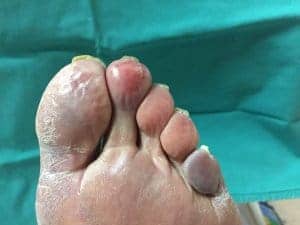
Raynaud’s Syndrome Symptoms
Those suffering from Raynaud’s Syndrome may experience tingling, numbness, burning, coldness, and/or a bluish discoloration in the toes, fingers, or tip of the nose.
Chilblains (Pernio)
If you have red patches, itching,blisters, or swelling of fingers and toes; you may have Chilblains!
Once Chilblains lesions and symptoms appear it may take 1-3 weeks to resolve; faster in warmer weather. This may come and go every winter. It’s imperative that you wear warm dry clothing and protect yourself from cold. Injuries are not usually permanent, but if not treated you risk infection to the damaged area, so see your Podiatrist. She can also recommend some additional prescription only treatment to prevent painful symptoms to begin with!
Can Smoking Make This Situation Worse?
Yes, smoking is really bad for anyone suffering from any sort of disease and Reynaud’s disease is no exception. The nicotine in cigarettes is known to constrict blood vessels, reduces blood flow which obviously triggers the symptoms of Raynaud’s disease. When smoking is continued, it damages blood vessels over time which increases the risk of complications and makes the condition even worse. Quitting smoking will help you live a healthier life and even prevent your Raynaud’s from getting worse as well.
Is Raynaud’s Disease More Common Among Certain Population?
Yes, Raynaud’s disease can be more common among certain population including:
- Women: Raynaud’s is usually more common in women compared to men, especially younger women who are under the age of 30.
- Colder Climates: Since Raynaud’s disease is all about your body parts getting cold, living in a col area can make Raynaud’s disease’s symptoms worse and can make you more likely to experience it.
- Family History: Unfortunately, Raynaud’s disease can be a genetic problem, if your parents or grandparents have suffered from it then there are chances you might too!
Can You Leave Raynaud’s Disease Untreated?
It’s possible to leave Raynaud’s disease untreated, but it can lead to complications unfortunately. This will lead to persistent episodes of irregular and reduced blood flow as well which will lead to sores and ulcers.
Chilblains image
You are more likely to have a Chilblains attack if you have already been told you have Raynaud’s disease. Raynauds looks very different symptom wise, but cause and treatments are related.
Complications: extremely painful when it gets to this point!
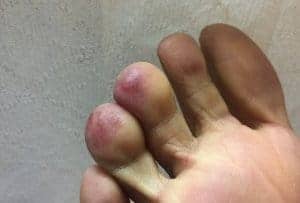
Infected wounds, ulcers and painful sore may develop as a complication to Raynauds and Pernio. Ulcers or Chilblains may cause complications if your skin blisters. This may become life threatening in Diabetic patients. Call your Podiatrist before it gets to this point.
+ Procardia, a blood pressure medication can be mixed in a cream base by prescription and can be applied before going outside.
+ Corticosteriods applied topically also relieve symtoms.
Click Here to E-mail Dr. Christina Teimouri
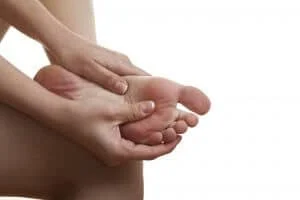

for body wraps and infrared heat treatments to keep you warm and cozy this winter and to rev up your metabolism call Body beautiful
Call Laser Treatments: at Body Beautiful 724-987-3221
10 locations to serve you
